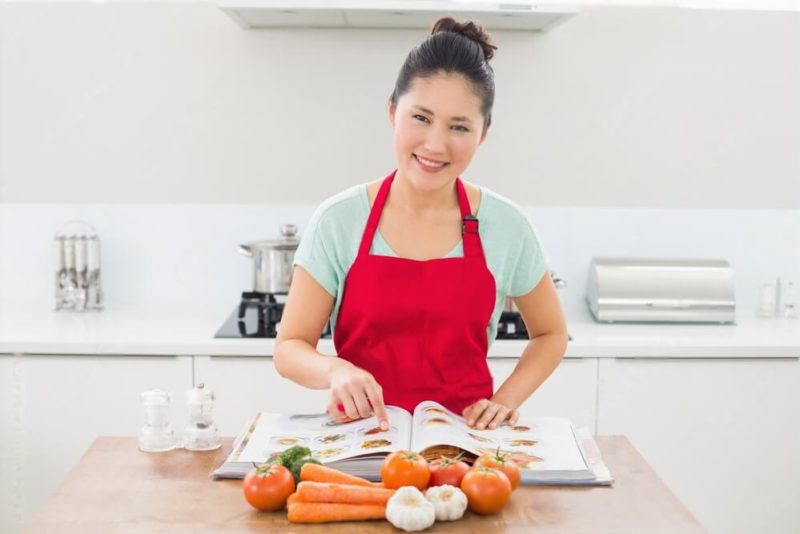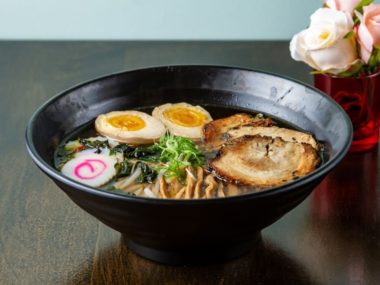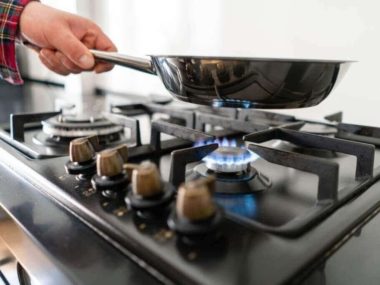Korean cuisine is one of the most popular in the world these days. From kimchi to kimbap, bulgogi to bossam, everyone wants to try this Asian taste sensation. Even that great American staple, fried chicken, is elevated to new heights when given a Korean makeover.
We’ve all watched Korean cooking shows and thought “I could do that!” But how easy is it really? Even those familiar with Asian flavors need a guide.
Therefore, in this review, we’ve checked out some of the best Korean cookbooks around. Who knows? Maybe we can help you find the perfect one for your next dinner party.
The Best Korean Cookbooks 2023 Reviews
1. Maangchi’s Real Korean Cooking: Authentic Dishes – Best Korean Cookbook by Maangchi
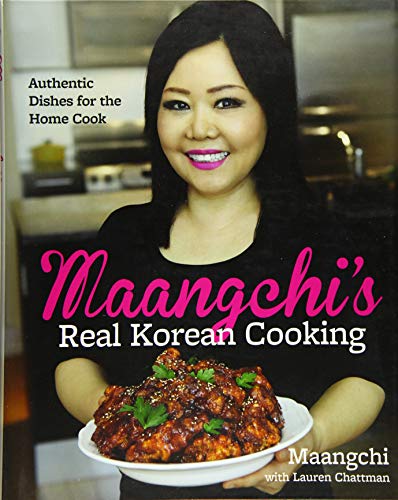
Make it with Maangchi
Let’s start with everyone’s favorite YouTuber, Maangchi. With over 5.15 million followers, her videos have been the go-to for many a home chef since 2007. With her straightforward recipes and upbeat commentary, her reputation as Korea’s answer to Julia Child is well-deserved.
But does this cookbook live up to that reputation?
Here, we have the complete package. For those unfamiliar with a typical Korean meal, she describes the key elements used and how they are most often served. She even gives detailed ingredient lists, and ideas of the type of equipment used when preparing Korean dishes.
She then goes on to offer a huge selection of authentic food. There are simple, 3-ingredient options such as spicy cabbage, for those who want to start off easy. For ambitious cooks, her Hae-mul pajeon recipe is sure to offer up a challenge that results in a delightfully light scallion pancake with seafood.
What if you’ve never cooked Korean food before?
Moreover, how will you know if it looks right? Well, a whopping 800 photos will put your mind at ease! There’s a picture to document every step. This gives that little extra peace of mind when cooking an unfamiliar cuisine.
These Maangchi recipes are the real deal. With side dishes, snacks, and complete meals, there’s something here for every occasion. And with Maangchi’s face smiling from every page, it offers a relaxed experience of Korean cookery.
PROS
- Great layout.
- Comprehensive introduction to Korean cuisine.
- Huge number of photos.
CONS
- Size is intimidating at first!
2. Korean BBQ: Master Your Grill in Seven Sauces [A Cookbook] Hardcover – Best Korean Cookbook for Meat Lovers
![Korean BBQ Master Your Grill in Seven Sauces [A Cookbook] Hardcover – Best Korean Cookbook for Meat Lovers Korean BBQ Master Your Grill in Seven Sauces [A Cookbook] Hardcover – Best Korean Cookbook for Meat Lovers](https://theeverydaykitchen.com/wp-content/uploads/2023/06/Korean-BBQ-Master-Your-Grill-in-Seven-Sauces-A-Cookbook-Hardcover-–-Best-Korean-Cookbook-for-Meat-Lovers.jpg)
Let’s get grillin’
Next up is this book from Bill Kim. A finalist of the James Beard Award, Chef Kim brings recipes from his bellyQ restaurant straight to your home. Meat lovers? This is one for you.
Is this a traditional Korean cookbook?
No, it isn’t. What we have here a Korean-American fusion. It takes good old-fashioned American BBQ and gives it a non-traditional twist.
With 80 recipes, the author has something for everyone at your next block party. He starts with a selection of master sauces and spice rubs, which can be used on a variety of meats. Then, we get an enormous array of side dishes, from classic edamame beans to a kimchi infused potato salad.
There are even desserts and drinks included! This book covers all bases. Whether cooking for one or entertaining guests, you’re sure to find the perfect dish.
What’s the best part?
Thanks to those master sauces, it’s easy to prepare everything in advance. In many of the recipes, we take a base and then combine it with other ingredients. This means the sauces can be made in large batches, then used as and when they are needed.
This is not just a Korean cookbook. It tells a story too. We learn of a chef taking a journey to understand his own heritage, adding a charming, personal element to the book.
With these Korean recipes, you can really feel the love.
PROS
- Excellent range of dishes.
- Inventive.
- Personal experience.
- Excellent for meat lovers.
CONS
- Not authentic cuisine.
3. Cook Korean!: A Comic Book with Recipes – Best Fun Korean Cookbook
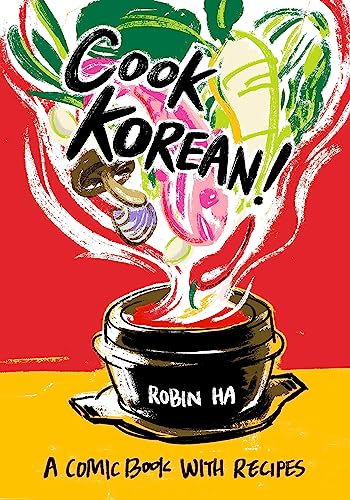
Comic strip (steak)
Now for a cute and quirky cooking experience. This is not just a recipe book. It’s a graphic novel as well!
But wait! How can a comic also be a cookbook?
With Dengki, of course! Dengki is a sweet, hanbok-wearing character, who acts as our guide through the world of Korean cuisine. Backed up by a group of fascinating personalities (dancing shrimp, anyone?) this is a charming, playful way to share delicious food in an easily accessible manner.
Don’t be fooled though! It may be fun, but that doesn’t mean there aren’t some seriously great recipes here. It’s light-hearted, whimsical format actually comes with some big, bold flavors.
How many recipes are there?
We get 64 in this book. While that’s not as many as some other chefs offer, it’s still a decent number. And as each comic strip is just one to three pages long, they’re generally pretty simple to make.
It’s awesome to discover some of the author’s own experiences, too. Our friend and guide Dengki shares insights and anecdotes, adding an intimate touch to our culinary experience. She doesn’t just teach us about Korean food; she casually educates us on Korean culture, too.
Basic but delicious…
Some of the recipes here are a little basic. But we can’t deny, they do taste good! For chefs taking their first steps into the world of cookery, this could be one of the best Korean cookbooks for you.
PROS
- Fun, engaging, format.
- Clear instructions.
- Beginner-friendly.
CONS
- Fewer recipes than some other books.
4. My Korea: Traditional Flavors, Modern Recipes – Best Korean Cookbook by Michelin Star Chef

Jung Sung
Heart and devotion. That phrase perfectly describes our next chef’s approach to cooking. Throughout this cookbook, Hooni Kim makes clear the importance of care and love when it comes to good food.
Why?
For Kim, food is a way of celebrating family and identity. And that really shines through here! This book is almost a love story, honoring his heritage, as well as his life as an immigrant in America.
We can see that in the recipes themselves. Bulgogi takes on an American twist, turning it into beef brisket sliders. They use those fabulous Korean flavors and present them in a way familiar to most home cooks.
So, it isn’t authentic Korean cooking then?
Actually, there are plenty of traditional recipes on offer. This is an awesome mix of old-school cool and modern inventions. We get Chef Kim’s own, personal take on food, which earned him his well-deserved Michelin Star.
That all might sound intimidating! But don’t worry. It’s actually quite straightforward.
Let us explain…
The book puts the reader at ease by clearly discussing commonly used ingredients. The instructions are thoughtfully presented, and easy to understand. Plus, they’re backed up by some stunning photography to compare your finished product to.
OK, it’s slightly more expensive than some other books around. But that’s reflected in the quality. Perhaps here, you get what you pay for.
PROS
- Beautifully presented.
- Well-respected author.
- Modern and classic recipes.
CONS
- Slightly pricy.
5. Korean Food Made Simple Hardcover – Best Judy Joo Korean Cookbook
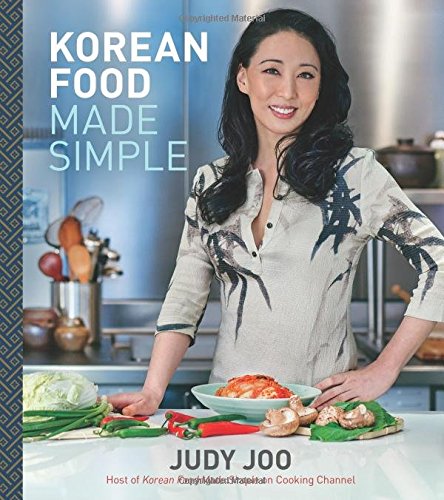
T.V. dinner
Up next we have a familiar face! Regular viewers of the Cooking Channel and Food Network will be sure to recognize our next chef. It’s the one and only, Judy Joo!
Easy to find ingredients…
Chef Joo makes Korean food accessible to everyone. Most ingredients can be found in your local supermarket, and they’re explained in detail throughout. Each recipe comes with an interesting and informative back story, to add a bit of local color to the meal.
But it’s not just for amateurs. Experienced cooks can learn something too. The chef includes some unusual flavor combinations, for an unexpected, but welcome, eating experience.
Are there a lot of recipes to choose from?
There sure are! We get an enormous 130 options here. In fact, there are so many that it can be overwhelming for a new, nervous chef.
However, although this book is a great companion for Joo’s T.V. show, it has so much more to offer. The recipes you already know and love are present, but there are others featured as well. It’s an awesome option for those inspired by the show, who want to delve deeper.
Are there any downsides?
Not all the recipes have pictures. Therefore, if you’re unfamiliar with the finished product then you’ll need to google it to check! While the photos are gorgeous, it would be nice to have more of them.
And, like many T.V. tie-ins, this book is quite costly. You really pay for that celebrity name.
PROS
- Familiar chef.
- Twists on traditional cuisine.
CONS
- Needs more visual examples.
6. The Kimchi Cookbook: 60 Traditional and Modern Ways to Make and Eat Kimchi Hardcover – Best Kimchi Cookbook
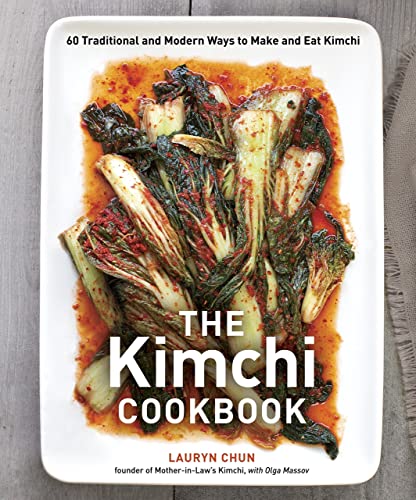
Packs a punch
Mention Korean food and what’s the first word on everyone’s lips?
Kimchi.
This classic side dish is everywhere these days. Kimchi fries, Kimchi hot dogs; we’ve even seen kimchi-topped nachos. This pungent little condiment really has taken America by storm.
But it’s just fermented cabbage, right?
Wrong! Kimchi can actually be made from a wide range of vegetables. And this book is here to show you how. Yes, there are time-honored cabbage recipes. But we also get cucumbers, tomatoes, and even butternut squash. There’s kimchi here to suit every palate and for all spice tolerances.
We learn how to use it, too. Kimchi isn’t just a side dish in this book. Use it to stuff dumplings, or as a flavoring in noodles. There’s even a recipe for a kimchi cocktail!
It is easy to make?
Yes, thanks to clear, no-nonsense instructions. And they’re supported by a series of inspiring photographs. The process is well-explained and uncomplicated, with no confusing or vague directions.
It’s not all business though. Along with the methods are a selection of chatty tales, describing life within this culture. You’ll feel like you’re talking to an old friend while preparing a variety of fresh, crunchy condiments.
What’s the catch?
Well, if you don’t like fermented vegetables, it’s not for you! But for everyone else, this book is a game-changer. A great way to elevate your Korean cooking experience!
PROS
- Suits different palates.
- Informative.
- Interesting, versatile recipes.
CONS
- Kimchi-based foods only!
7. Seoul Food Korean Cookbook: Korean Cooking from Kimchi & Bibimbap to Fried Chicken – Best Korean Cookbook with Korean Eating Customs
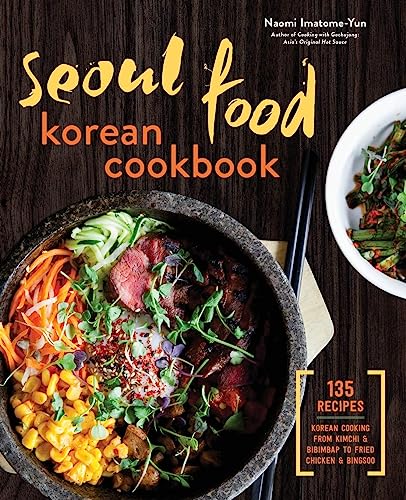
Heart and Seoul
With a whopping 135 recipes, this book covers all bases! Soups, stews, stir-fries; you name it, it’s here. There’s even a chance to make everyone’s favorite dessert, Bingsoo!
And that’s not all…
This book also discusses culture. More than just a collection of recipes, this is the complete guide to Korean cookery. We can learn about table manners, and customs when eating, giving a truly authentic experience.
And we discover foods from different parts of the country as well. After all, every American state has a regional delicacy, and Korea is no different. Discover how flavors and cooking techniques differ in various regions.
Is it suitable for beginners?
Absolutely. In fact, this cookbook contains comprehensive lists of everything a budding chef needs to get started. Approaching a new cuisine for the first time can be intimidating, but this book puts the reader at ease.
It offers substitutions, too. Let’s face it, ingredients like these can be difficult to find, especially in rural communities. This cookbook has handy suggestions for accessible alternatives that won’t change the taste of the dish.
That sounds too good to be true! Is it?
There is one issue here. There are very few pictures of the finished item. Though there are handy photos to illustrate the process, there aren’t many to show us what it should look like at the end.
But, that’s a minor criticism. Overall, this is an awesome cookbook. And at an extremely reasonable price!
PROS
- Details of Korean customs.
- Substitution suggestions.
CONS
- Lacks images.
8. Vegetarian Dishes from My Korean Home: Flavorful Korean Recipes in Simple Steps Paperback – Best Vegetarian Korean Cookbook
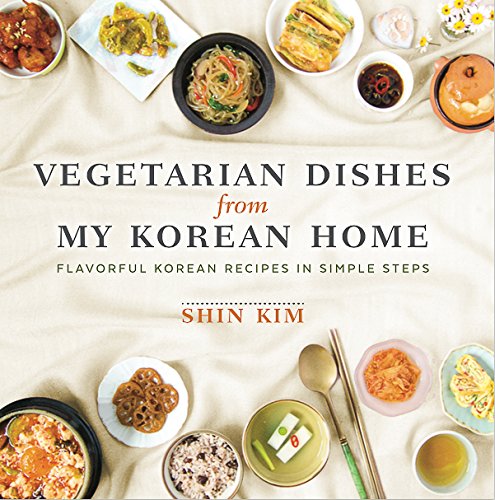
Meat-free meals
Korean food does tend to be meat-heavy. Even the most innocent looking dishes are often prepared using stock made from animal products. For plant-based eaters, it’s sometimes difficult to navigate a Korean menu. However, the best Korean cookbooks are not always meat-based.
With this book, you can create meat-free dishes from the comfort of your own home! Containing 30 recipes, it has a decent range of options for any vegetarian. Not only that but as it’s vegetable-based, most of the recipes are pretty healthy, too.
Is it suitable for vegans?
Yes. 25 of the dishes can be adapted to contain no eggs, dairy, or any other animal-based products. Many recipes are gluten and nut-free as well, to suit specific dietary requirements.
Flavor is the name of the game this time. While Korean food is often known for its bold, umami seasonings, we get more of a range here. Sure, it uses plenty of gojuchang paste, but there are also some more subtle tastes on offer.
Can carnivores use this book?
Yes! If meatless Mondays really aren’t for you, then most of these dishes could be served as side items. Why not throw a big, juicy steak on the grill, then serve it with a fabulous dish of peppers in a sesame dressing?
It would be nice to have a few more recipes. Moreover, for the price, this book is on the skimpy side. But for foodies that follow a plant-based diet, this is an awesome way to spice up your life!
PROS
- Suitable for special diets.
- Ideal for many palates.
- Healthy options.
CONS
- Needs more recipes.
9. My Rice Bowl: Korean Cooking Outside the Lines Hardcover – Best Professional Korean Cookbook
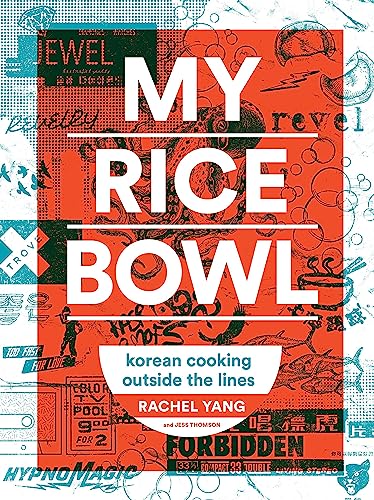
Fusion illusion
When we first think of fusion food, we usually picture a blending of two cultures. But with My Rice Bowl, Chef Rachel Yang takes inspiration from all over the globe! With her quirky take on everything from meat curries to saucy pad thai, she really pushes the boundaries of modern Korean cuisine.
That sounds intimidating…
At first glance it is! There’s a lot to take in. We get detailed ingredient and equipment lists, as well as tales from the author about Korean life.
But, once you’ve gotten over the initial wall of information, this book is actually pretty straightforward. Concise instructions are well-presented, making the cooking techniques simple to learn. There are a few technical terms, but with a little research, it’s certainly doable.
Why is it called ‘The Rice Bowl’?
Because the structure of the book mirrors the place rice occupies in Korean cuisine. Rice is the staple, the backbone, the structure that holds each element of the meal together. It forms the basis of the dish, to support all those tasty meats and veggies we eat it with.
And that’s just like this book. First, we learn the fundamentals of cookery, the rice in this metaphor. Then we can build on that using the more complicated recipes on offer.
Superb for the professionals…
This might be one of the best cookbooks for seasoned chefs we’ve seen! However, for the casual foodie, it may be a bit too much work. We have to say though, there’s a lot to like here!
PROS
- Huge amount of detail.
- Great creativity.
- Extremely informative.
CONS
- Requires study!
10. Growing up in a Korean Kitchen: A Cookbook Hardcover – Best Korean Memoir Cookbook
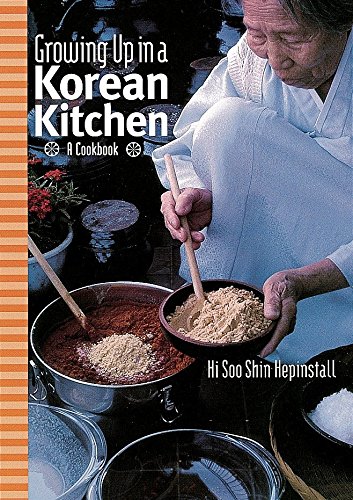
Satisfy your Seoul
Variety is the spice of life with our next cookbook. There are a whopping 250 recipes in this hardcover! From light snacks to sumptuous feasts, you’ll find something for every occasion.
Do you enjoy recipes with a personal touch?
This is not just an instruction manual for making incredible food. There’s an autobiographical side to it, too. The author shares stories of her life in Korea, as well as her beloved family memories.
And speaking of family; many of these recipes have been passed down for generations. Originating with the chef’s ancestors, they’ve been orally handed down from throughout the years. Now for the first time, they’ve finally been written down, to share the family’s love with the wider world.
So, it has a charming background. But, let’s get down to the most important question.
What’s the food like?
This is classic Korean cookery. They are traditional recipes, found in the family home. There are delicate salads, warming stews, and complexly flavored barbecued meats on offer.
But traditional doesn’t mean simple! Some of these meals are pretty elaborate. Busy people hoping to prepare a quick, midweek meal, should look elsewhere!
Fantastic Korean creations…
However, if you have the time and energy to put the work in, then it’s awesome. With a little patience, anyone can produce a fantastic Korean menu. And we just love that personal touch too.
PROS
- Part cookbook, part memoir.
- Family oriented.
- Huge number of recipes.
CONS
- Complicated!
11. Korean Home Cooking: Classic and Modern Recipes Hardcover – Best Korean Cookbook for Beginners
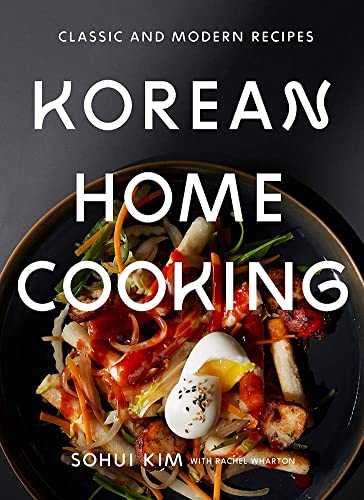
Slight of hand
Sohnmat. This Korean concept doesn’t have an exact English translation, but we could describe it as ‘taste of the hand’. It’s the ability to choose the perfect combination of ingredients that so many cooks strive for.
Chef Sohui Kim has that talent. And with this cookbook, she shows how you can achieve it too! Learn how to balance savory, spicy, and sweet flavors for the perfect Korean experience.
That sounds complicated…
Not really. Most of the recipes are extremely easy to follow. The instructions are clear and concise, giving the home chef confidence even when making unfamiliar dishes.
And of course, they’re supported by helpful photographs. They clearly represent how the finished dish should look. That’s always useful when making a kind of food we’ve never tasted before.
Besides, those pictures aren’t just of food. There are snapshots of traveling throughout the country too. Stunningly beautiful, they’re sure to inspire even the beginner chef to produce some truly incredible meals!
Does it teach us about Korean culture?
It sure does. This book is packed full of anecdotes and reflections on life in Korea. Chef Kim’s love for her heritage shines through, making this cookbook a real labor of love.
Experienced chefs might find it a bit unchallenging. However, simplicity allows those incredible flavors to burst through. There something for everyone in this homage to traditional Korean food.
PROS
- Fabulous photographs.
- Straightforward methods.
- Insight into Korean life.
CONS
- Very experienced chefs will find it too easy.
12. Koreatown: A Cookbook Hardcover – Best Korean Cookbook for Western Tastes
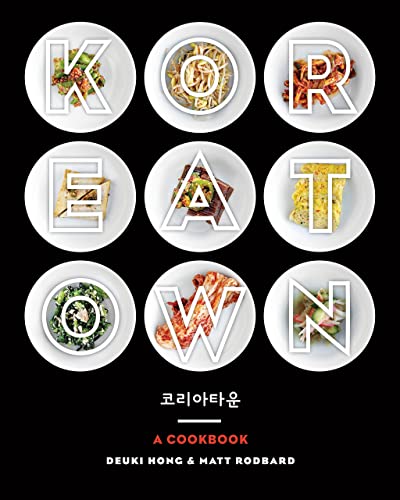
Seoul-searching
And finishing our best Korean cookbooks review, we have this New York Times bestseller! The aptly named “Koreatown,” features American-Korean recipes, such as you’d find in your city’s local Asian quarter.
So, it’s fusion food?
Not exactly. You won’t find gojuchang pulled pork or bibimbap tacos here. Instead, we get typical Korean eats adjusted for a western palate.
But that doesn’t mean the recipes are inauthentic. They’re exactly what you’d find at your local Korean town restaurant in America. They have all the taste and aroma of great Korean food, without sticking too closely to tradition.
That non-traditional slant is reflected in the names of the dishes, too. A fried rice dish becomes “our mildly insane kimchi bokkeumbap.” There’s a bibimbap entitled “this is not a bibimbap.” These names add a funky sense of adventure and originality to the food.
Is it illustrated?
Yes, with some genuinely incredible photographs. And they don’t show some romanticized ideal of Korea. Appetizing and appealing, they reflect a modern American K-town with bold colors and contrasts.
There are interviews and essays as well. Therefore, this book gives the reader a well-rounded impression of this blended culture. Moreover, it shows how well two entirely different countries can come together to produce an amazing new experience.
A modern approach…
This food might not be what you’d find in a Daegu marketplace. But it shows how traditions can be adapted to suit a wider audience. Maybe here, the authors have proven that the old ways aren’t always best.
PROS
- Suitable for Western and Korean tastes.
- Realistic photos.
- Modern cuisine.
CONS
- Some chefs prefer authenticity.
So Which of These Best Korean Cookbooks Would We Choose?
Who knew there were so many ways to cook Korean food?
In this review, we saw books for every level of experience and to suit every palate. But there can only be one winner. And we’ve chosen the…
Maangchi’s Real Korean Cooking: Authentic Dishes for the Home Cook Hardcover
That’s because this cookbook is the full package. It has those old-school, time-honored recipes we know and love. But then we get some modern twists, and influences from American food culture, too.
Plus, it’s well-written, informative, and straightforward. The recipes don’t have any unclear directions or confusing techniques. And we just love those incredible photographs as well.
So, happy Korean cooking, folks!
